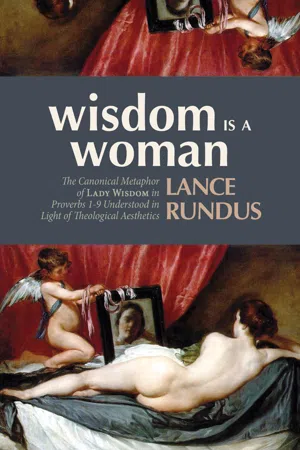![]()
1
Introduction
A Survey of Difficulties in the Treatment of the Metaphor of Lady Wisdom
In Proverbs 1–9, the abstract concept of wisdom is personified as a woman; as such this Lady Wisdom exists as a metaphor in which some qualities of what we know as a woman are intended to teach us something about what we do not know about wisdom. Following a traditional definition of metaphor, the term woman may be described as a vehicle or source because it functions as a source of concepts or entailments which then are to be purposefully understood in relation to the tenor or target of the metaphor (i.e., wisdom). So, in the metaphor, “This room is a pig-sty.” The source category, pig sty, is chosen to provide elements of comparison to the target category of room. In this case the relative disorder of the room is to be illustrated with regard to the housekeeping habits of swine. Therefore, in light of the discussion of personified wisdom (Lady Wisdom), common sense would dictate that something about woman is supposed to provide the reader with insight about wisdom. However, as will be seen in the literature review, the metaphor of WISDOM IS A WOMAN has been historically problematic, with interpreters substituting a wide range of different source categories in place of that set forth by the text. Therefore, the ultimate aim of this work is to consider what elements of women and womanhood are highlighted in Proverbs 1–9, and how these entailments help us to approach and understand wisdom as an abstract entity.
However, this ultimate aim is immediately complicated by reality. First, the historic difficulty in establishing clear entailments for the metaphor of WISDOM IS A WOMAN is due in large part to the lack of a clear, consistent and meaningful definition of metaphor. Without an understanding of what metaphor is (i.e., ornamental function of speech or organizing function of mind) and how it works within a poetic text there will be a necessary unraveling of stable conclusions. Second, as will be seen in the review of literature, in too many cases the target of the metaphor—that of acquiring wisdom—has been lost in the search of the identity of the metaphorical vehicle or source. As will be illustrated below, many studies end up being so focused upon Lady Wisdom, that they lose track of the fact that the woman part of the metaphor only exists to provide and understanding of the wisdom part. In the following study, the aim of understanding and obtaining wisdom must remain central. However, this presents yet another subsidiary problem. In the book of Proverbs the experience of wisdom is deeply inter-subjective and dependent upon the correct inward disposition of the reader. As such the ambiguous poetic expression that is characteristic of wisdom is adversarial to the scientific empiricism of the modern west. Wisdom challenges our western materialistic and empirical epistemology and therefore our basic assumptions of perception, knowledge, and ontology. As will be discussed at greater length below, wisdom is characteristic of right hemispheric thinking that is essentially relational, empathetic, perceptive, and aesthetic in nature. In this it is helpful to consider an illustration from the world of art.
Engaging Lady Wisdom in Proverbs 1–9 is akin to approaching Diego Velázquez’s, Venus at her Mirror (aka Rokeby Venus) (fig. 1). Approaching this work as though it were a linear string of propositions, or endeavoring to discover the historical background, would bring us no nearer to understanding the deified personification of love that reclines both openly and obscurely before us. Rather, the aesthetic requires a different sort of perception:
Figure 1. Diego Velázquez, Venus at the Mirror (Rokeby Venus), (1648–51, oil on canvas, 122.5 x 177 cm, National Gallery, London).
To really experience this artwork is a complex matrix of careful attention, reflection and openness that transcends a simple true-false propositionalism. Our attention to Lady Wisdom within the pages of scripture should be no less enthralling and no less rigorous. In the same way that one might take a seat across from the Rokeby Venus in the National Gallery in London, we shall endeavor in what follows to trace the contours of Lady Wisdom’s face in Proverbs in light of the broader context of the diverse and dichotomous presentation of woman in the book of Proverbs.
As an opening caveat, it is important to note that both Lady Wisdom and the Rokeby Venus exist in some sense as “dangerous pictures.” For the Rokeby Venus, it was produced in defiance of the dictates of the Spanish Inquisition regarding nude painting, by a Spaniard at the height of the Inquisition’s power. As early as 1640, Spanish artists who painted female nudes were threatened with excommunication, fines and banishment. Despite this fact, Velázquez not only painted a nude but painted a nude from a live model. Moreover, the Venus is painted life-size, or aequalitas, a mode typically reserved for religious work.
In a very similar way, Lady Wisdom is a dangerous picture because first of all she is described in terms and metaphors reserved fo...

